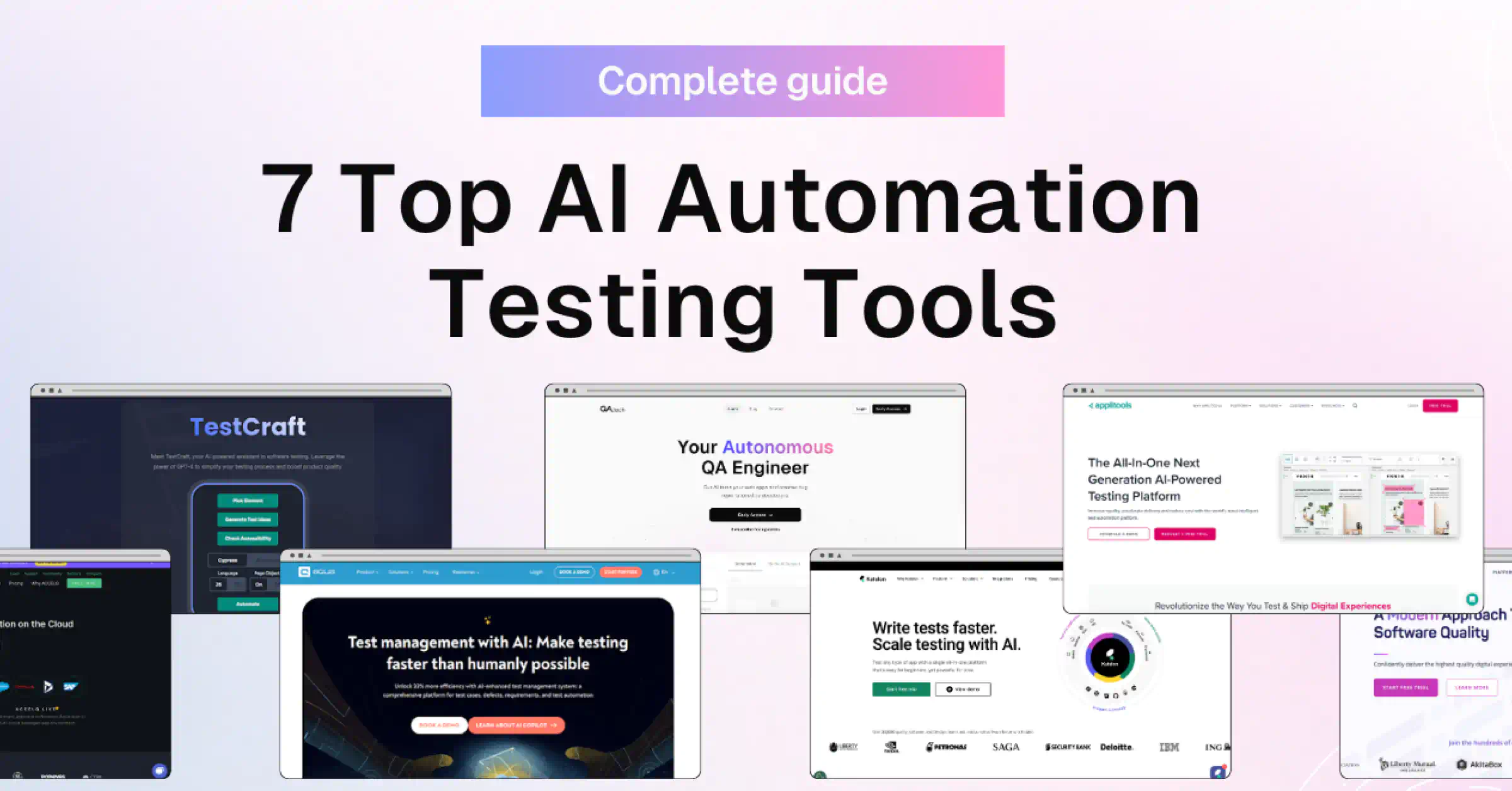AI UI testing has revolutionized the way we approach quality assurance, and with so many tools available, choosing the right tool can be overwhelming.
In this article, we’ll explore the best AI UI testing services to help you make an informed decision.
Here’s a brief overview of the top AI UI testing tools:
- QA.Tech – Top recommendation for comprehensive AI QA testing
- Applitools – Recommended for comprehensive AI-powered visual testing and monitoring
- Rainforest – Recommended QA testing tool for ease of use and AI-driven testing
- Mabl – Scalable and adaptable AI testing tool for automated and continuous testing
- Functionize – Recommended for excellent user experience and functional testing
- TestRigor – Recommended for accelerated QA testing and test automation
- Kobiton – Recommended for mobile testing and device lab management
- Selenium – Recommended for open-source and customizable automated browser testing
- Appvance – Recommended for comprehensive and automated QA testing with AI and machine learning
- Cucumber – Recommended for behavior-driven and efficient acceptance testing and automation
- Postman – Recommended for API testing, development, and monitoring
What Is AI UI Testing?
AI UI testing involves using artificial intelligence and machine learning algorithms to automate the verification and validation of the graphical user interface (GUI) of a software application.
It checks the performance, visual elements, functionality, and user-friendliness of your application’s user interface, ensuring it’s intuitive, responsive, efficient, and in compliance with predefined standards.
Also, AI UI testing simulates the actions and behaviors of a user engaging with an application’s interface.
According to Sweor, user experience is crucial in website engagement and customer loyalty. The statistics reveal:
- Nearly 40 percent of users will leave a website if it provides a subpar user experience.
- Over 50 percent of users are unlikely to recommend a company with a non-mobile-friendly website to their friends.
- Eighty-eight percent of users claim they won’t revisit a website if they encounter a negative user experience.
These statistics highlight the importance of prioritizing UI testing to ensure a positive user experience and avoid potential loss of customers.
Also, a report by Software Testing Help and Bytebeam reveals that 30 percent of developers show a preference for test automation over manual testing. This preference for automated testing, known for its speed, significantly reduces development time, leading to more efficient testing processes.
What Are the Requirements for High-Quality UI Testing?
Before deciding which tool is best for your UI testing needs, ensure the tool meets the following requirements to get high-quality results.
1. Comprehensive Test Coverage
This requirement involves thorough testing of all aspects of the user interface, including visual elements, functionality, and user experience.
Choose a tool that offers robust visual testing capabilities to detect UI issues such as layout inconsistencies, design flaws, and visual regressions across various browsers, devices, and resolutions. This can help ensure pixel-perfect rendering and consistency in UI appearance.
Also, choose a tool that supports the functional testing of all the interactive elements of the UI. This will help ensure buttons, forms, and navigation menus behave as expected under different usage test cases.
It should also be able to simulate real user interactions and scenarios, identify areas for improvement and optimize the overall user experience.
2. Efficient Test Creation and Execution
Efficiency in test creation and execution are crucial elements for maintaining agility and accelerating the UI testing process. It can also help you streamline testing processes, accelerate release cycles, and deliver high-quality software products to market more efficiently.
UI test tools that have scriptless test automation capabilities allows testers with no coding experience to create and execute tests efficiently. This in turn reduces the time and effort required for test creation.
Also, parallel test execution enables multiple test cases to run simultaneously, significantly reducing test execution time. You can leverage a tool with these testing capabilities to execute tests across different browsers, devices, and configurations concurrently.
Ensure it has AI-powered test prioritization algorithms, which help to identify critical test cases and prioritize them based on various factors such as risk impact, code changes, and business priorities.
3. Real-Device Testing
Real-device testing is crucial to ensure that applications work seamlessly across different platforms, devices, and configurations. This requirement validates the compatibility, performance, and user experience of applications in real-world scenarios.
A UI testing tool with this capability can help identify and address device-specific issues. It can also help optimize performance and deliver a consistent user experience across all platforms and devices.
Also testing under different network conditions, such as 3G, 4G, 5G and Wi-Fi, helps evaluate application performance and responsiveness under varying network bandwidths and latencies.
Real-device testing also allows testers to evaluate the application’s responsiveness to user interactions, gestures, and inputs. This includes testing touch gestures, screen orientations, and device-specific features, ensuring a seamless and intuitive user experience across different devices and usage scenarios.
Features to Consider When Choosing Website QA Testing Tools
When selecting website QA testing tools, it’s crucial to ensure they meet the specific needs of your software development team.
Here are five essential features to consider when choosing website QA testing tools, along with detailed explanations of each:
1. Visual Testing Capabilities
Visual testing capabilities allow for the detection of UI layout issues, design inconsistencies, and visual regressions across different browsers, devices, and screen resolutions. This feature ensures pixel-perfect rendering and consistency in UI appearance, enhancing the overall user experience.
The tool should support testing across various browsers to ensure consistent rendering and functionality across different browser environments.
The tool should also facilitate testing of responsive design elements to ensure that the UI adapts seamlessly to different screen sizes and orientations.
2. Test Script Generation
Automatic test script generation streamlines the testing process by reducing manual effort and increasing test coverage.
This feature enables testers to create test scripts quickly and efficiently, ensuring thorough testing of all UI functionalities. It
should support scriptless test automation, allowing testers to create and execute tests without writing code.
For advanced users, it should also allow for the generation of test scripts using code, providing flexibility and customization options. The tool’s interface should be user-friendly and intuitive, enabling testers to generate test scripts effortlessly, even without extensive technical knowledge.
3. Cross-Browser and Cross-Platform Support
Cross-browser and cross-platform support are essential for ensuring that the application functions correctly across different browser environments, operating systems, and devices. This feature validates compatibility and helps prevent issues related to browser-specific behaviors.
The tool should support testing on a wide range of browsers such as Chrome, Firefox, Safari, and Edge, to ensure broad browser compatibility.
It should also support testing on various operating systems and different devices to validate compatibility across different platforms and to ensure consistent performance and functionality across all devices.
4. Integration with CI/CD Pipelines
Integration with Continuous Integration/Continuous Deployment (CI/CD) pipelines facilitates seamless testing as part of the software delivery process. This feature enables automated execution of tests, rapid feedback loops, and continuous improvement of the development workflow.
The tool should integrate seamlessly with popular CI/CD platforms, such as Jenkins, Travis CI, CircleCI, and GitLab CI, allowing for automated test execution triggered by code changes.
It should support automated deployment of test environments and applications, enabling end-to-end automation of the testing process from code commit to deployment.
5. Comprehensive Reporting and Analytics
Comprehensive reporting and analytics features provide actionable insights into test results, enabling you to identify and prioritize issues for resolution. This feature enhances collaboration, facilitates decision-making, and drives continuous improvement in the testing process.
The tool should generate detailed test reports that provide insights into test execution results, including pass/fail status, error messages, screenshots, and performance metrics.
It should also offer customizable dashboards and visualizations to track key testing metrics, trends, and progress over time, empowering teams to monitor project status and identify areas for improvement.
Additionally, the tool should integrate with issue tracking systems, such as Jira, Trello, or GitHub Issues, to facilitate seamless communication and collaboration between testing and development teams for issue resolution.
Our Top 11 Recommended AI Testing Services
1. QA.tech
QA.tech is an AI-driven autonomous testing platform that streamlines testing procedures and enhances software quality. Its intuitive interface and user-friendly features simplify the testing journey for users.
Features
- Automated test case generation and test replay.
- Real-time monitoring.
- Browser-based testing with dynamic adaptation.
- Predictive analytics and AI unit testing.
Pros
- Detects and fixes broken forms, enhancing customer retention rates
- Saves money spent on manual QA and infrastructure
- Speeds up new feature deployment
- Automated testing with AI agent
Cons
- It could be constrained by how well the browser performs.
- It may not handle heavy testing scenarios efficiently
Pricing
QA.tech’s pricing is not publicly disclosed on the website, but you can find out how much it costs by applying for early access.
2. Applitools
Applitools is a comprehensive AI-powered visual testing and monitoring tool that ensures perfect digital experiences.
Features
- AI-powered visual testing
- Automated test case generation
- Real-time monitoring
- Browser-based testing
- Easy integration with project management tools
Pros
- Provide fast and accurate testing
- User-friendly interface.
- Supports cross-device and browser testing
Cons
- Limited customization
- Struggles to handle frequently changing dynamic content
- It is expensive for small teams or projects.
Pricing
- Free plan
- Starter plan
- Eyes plan
- Ultra Test Cloud plan
Applitools did not specify its paid plans price on its official website but you can contact their sales department for more details.
3. Rainforest
Rainforest is a user-friendly QA testing tool that leverages AI-driven testing for efficient and accurate results.
Features
- AI-driven testing
- Automated test case generation
- Real-time monitoring
- Browser-based testing
- Easy Integration with project management tools
Pros
- Fast and accurate testing
- User-friendly interface
- Easy and effective automation of test cases
Cons
- Test cases sometimes fail and then run without any changes from the user
- It does not support parallel test execution
Pricing
It is not publicly disclosed on the website, but you can find out by contacting their sales department.
4. Mabl
Mabl is a scalable and adaptable AI testing tool for automated and continuous testing.
Features
- Automated test case generation and test replay.
- Real-time monitoring and dynamic adaptation.
- Browser-based testing and predictive analytics.
- Easy integration with project management tools
- Low-code training options
Pros
- It provides accurate and fast testing
- User-friendly interface
- Low-code options made it accessible for non-technical team members
Cons
- Test script design and modification are a bit challenging
- It does not provide a comparative analysis between production and development environments (or across various software versions)
Pricing
- Free trial
Other pricing plans are tailored to the user’s needs, you can contact their sales department for more information on their pricing.
5. Functionize
Functionize is a user experience and functional testing tool that ensures excellent digital experiences.
Features
- User experience testing
- Functional testing
- Automated test case generation
- Real-time monitoring
- Browser-based testing
- Integrates with project management tools.
Pros
- Perform comprehensive testing
- User-friendly interface
- Support parallel test execution
Cons
- It has a learning curve and might require team training to use the tool efficiently
- It does not support test parameterization
Pricing
- Free trial
Other pricing plans are tailored to the user’s needs, you can contact their sales department for more information on their pricing.
6. TestRigor
TestRigor is an accelerated QA testing tool that leverages AI and machine learning for efficient testing.
Features
- Automated test case generation
- Real-time monitoring
- Browser-based testing
- Dynamic adaptation
- Predictive analytics
- Integration with project management tools
Pros
- Fast and accurate testing
- Cost-effective, eliminating the need for expensive developers
- Excellent choice for building a scalable software testing process
- Codeless solution suitable for non-technical teams
Cons
- The tools sometimes crash, leading to test case failure
- Lack of educational materials for companies new to software testing
Pricing
- Free trial
- Private Linux Chrome plan (from $99/month)
- Private complete plan (from $900/month)
- Enterprise plan (custom prices).
7. Kobiton
Kobiton is a mobile testing and device lab management tool that ensures seamless mobile experiences.
Features
- Supports mobile testing and device lab management
- Automated test case generation.
- Browser-based testing
- Integration with project management tools
- Supports testing for applications across multiple countries
Pros
- Provides comprehensive mobile testing
- Fast and efficient
- Rapid and exceptional support team
- Quick setup and easy to use with little to no learning curve
Cons
- Occasional slow connectivity
- Sometimes unresponsive to user input
- The touch gestures can be occasionally unresponsive and tricky to master
Pricing
- Free trial
- Startup plan (from $83 / month)
- Accelerate plan (from $399 / month)
- Scale plan (from $9000 / year)
- Enterprise plan (custom).
8. Selenium
Selenium is an open-source and customizable automated browser testing tool.
Features
- Open-source
- Highly customizable
- Automated browser testing
- Integration with project management tools.
Pros
- Highly customizable
- Cost-effective
- Fast and efficient.
Cons
- Steep learning curve
- Its functionality is restricted to web applications
- Limited capabilities
Pricing
- Free (open-source)
9. Appvance
Appvance is a comprehensive and automated QA testing tool that leverages AI and machine learning.
Features
- Automated test case generation
- Dynamic adaptation
- Predictive analytics
- Drives true user behavior and actual response rates
- Immediate access to live drill-down reports
Pros
- Fast and accurate testing
- Customizable tools
- Scalable to test millions of virtual users
- Provides immediate access to live drill-down reports
Cons
- There are concerns about the tool’s compatibility with popular databases like Oracle, MySQL, SQL Server, PostgreSQL, and Derby DB
- The current capabilities of the tool are limited by a lack of flexibility, data collation, and export format options
- Occasional delays in its processing queue
Pricing
- Free trial
Other pricing plans are tailored to the user’s needs, you can contact their sales department for more information on their pricing.
10. Cucumber
Cucumber is a behavior-driven and efficient acceptance testing and automation tool.
Features
- Behavior-driven testing
- Acceptance testing
- Automated test case generation
- Real-time monitoring
- Browser-based testing
- Integration with project management tools.
Pros
- Provides flexibility in creating tests that align with user-centered behaviors
- Allows for conversion of many UAT test cases to automated tests
- Focuses on quality, ensuring tests are user-centric and effective
Cons
- Its complexity makes maintenance harder.
- It has poor implementation, leading to unclear or overly complex steps.
- It’s not very readable for non-coders
Pricing
- Free trial
- Starter plan ($32 per user/month)
- Cloud plan ($37 per user/month)
All paid plans are billed annually.
11. Postman
Postman is an API testing, development, and monitoring tool that ensures seamless API experiences.
Features
- API testing
- API development
- Real-time monitoring
- Integration with project management tools.
Pros
- Comprehensive API testing
- Simple to integrate into systems
- Allows for organization of APIs into collections
- Helpful for debugging and identifying issues
Cons
- Frequent use can cause the application to crash and exit
- GUI intensive
- Limited offline functionality
Pricing
- Free plan
- Basic plan ($14 per user/month)
- Professional plan ($29 per user/month)
- Enterprise plan ($49 per user/month).
All paid plans are billed annually.
Conclusion
Choosing the right AI UI testing tool can be a daunting task, but with this guide, you’re one step closer to ensuring your application’s user interface is seamless and efficient.
Remember to consider your team’s specific needs and choose a tool that aligns with your goals and prioritize tools that offer robust AI unit test generation capabilities.
Is your company looking to streamline UI testing and enhance overall product quality using AI?
QA.tech offers a cutting-edge, AI-powered solution for autonomous UI testing. This will help your team focus on core development while reducing bugs and ensuring exceptional user experiences.
Contact us today to learn how QA.tech can help you achieve testing efficiency and drive business success!
FAQs
1. What is AI UI testing?
AI UI testing uses artificial intelligence and machine learning algorithms to automate the testing process, ensuring your application’s user interface is intuitive, responsive, and efficient.
2. Which tool is best for UI performance testing?
QA.tech is a cutting-edge tool for UI performance testing, offering real-device testing, comprehensive test coverage, and fast test creation and execution to ensure exceptional user experiences.
3. How do I choose the right AI UI testing tool?
Consider your team’s specific needs, the features offered by each tool, and the pricing plans to choose the right AI UI testing tool for your application.








